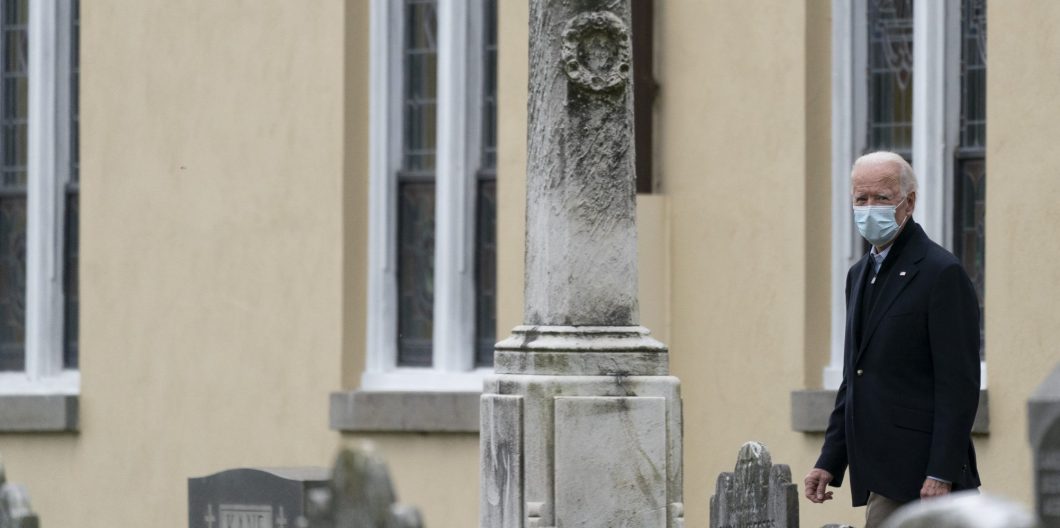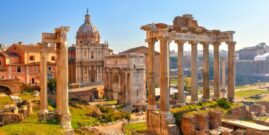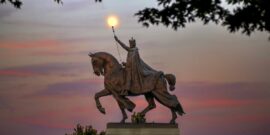Government has a legitimate role in preserving peace, but it cannot make men virtuous.
American Catholicism in the Dock
To say that Roman Catholicism in the United States is American in flavor is to border on bland. What would you expect? If the Vatican has tilted Italian throughout its history, how could a church with almost five hundred years of presence in North America and seventy million members in the United States, most native born, not bear the marks of its country’s environment? Bishop J. Fulton Sheen may have looked odd on his prime-time television show, Life is Worth Living, with all of his episcopal garb. But neither his appearance nor his allusions to Aquinas and Augustine prevented him from winning two Emmys a decade before Vatican II formally opened the Church to modernity. But for some, the Americanness of the American Church is objectionable since the nation’s combination of lax Protestantism, commercialism, vulgarity, and individualism run contrary to Rome’s ministry and forms of devotion.
This is another way of saying that to talk about American Catholicism requires some reckoning with Americanism itself. Some historians have celebrated the Americanness of the Church, such as Jay Dolan, whose book, In Search of American Catholicism (2002), praised the nation’s democratic ethos, a point that helped the author’s not-so-hidden advocacy for the laity. Other historians have been more critical of the national character of American Catholicism while still acknowledging the valuable contributions made by clergy and laity who blended faith and American political traditions. Here a good example is John McGreevy’s Catholicism and American Freedom (2003) which argued that Roman Catholicism was not foreign to American politics even if clergy and theologians advocated liberty in ways that guarded against individualism and libertinism. These are simply two examples of many works that reveal an American Church adapting to its political environment without abandoning the faith.
In fact, in the annals of religious history, the American Church is one more of the many instances of the American success story. The reason has to do with the Church’s immigrant past and the success of religious, priests, and bishops in setting up a communion under adverse circumstances. As Charles Morris observes in American Catholic (1997), until the mid-19th century influx of Irish immigrants, the American Church was “a small, polyglot affair, quietly adapting to a Protestant country.” Then four decades later came waves of German, Italian, and Eastern European immigrants, which raised questions not only of assimilation to the host society but also the limits of a melting-pot church: “When the smoke cleared, the Church had arrived at the grand American Catholic compromise that was to prevail for most of the next century.” For much of the 19th century, American bishops had freedom to chart their course because the Vatican had plenty on its plate with European affairs. When the Vatican finally began to pay closer attention to the U.S., thanks mainly to the large numbers of immigrants settling in America and sending reports back to the Old World, officials landed gently on Americanism as a threat. Even so, Leo XIII’s 1899 condemnation of Americanism as a heresy was mild. It was one part instruction to Americans and another a way to pacify conservatives in France who may have been more “Catholic than the pope” and upset about the American Church’s “liberalism.”
Catholic Americanism?
This perspective—a church of meager origins overcoming significant odds—is one that seldom registers with recent criticisms of the Americanism that has characterized the American Church since Vatican II. Selling out to the Republican Party or to consumer capitalism is one way of objecting to assimilation. But the entire history of the American Church (maybe even the history of Roman Catholicism) has revealed a communion remarkably adaptive to local customs and institutions. In politics, Al Smith, the Democratic presidential nominee in 1928 and then President John F. Kennedy showed no hesitancy in working the levers of American government, local or national. Meanwhile, the bishops either looked on with silence or assisted church members who took vows to uphold state and federal constitutions even as anti-Catholic critics insisted such oaths were taken with crossed fingers. In reality, most members and clergy in the American Church never lived the way the Amish do—with a faith that stands aloof from national life. So American has the American Church been that neo-conservatives (also known as neo-Americanists) like Richard John Neuhaus, George Weigel, and Michael Novak, were not the only ones blending faith and patriotism. According to R. Scott Appleby, the “neo-Americanist center” of the American Church “expanded to include progressives who sought to ‘democratize’ elements of Catholic social doctrine.” Indeed, both conservative and progressive American Catholics “took the American model as exemplary and exportable, more so than did even the original Americanists.” Only “isolated traditionalists” and “scattered social radicals,” Appleby has argued, have failed to “embrace American ideals unapologetically.”
This background is important for situating Massimo Faggioli’s assessment of American Catholicism. Faggioli, a professor of theology at Villanova University of Italian heritage, uses the newly elected POTUS, Joe Biden, as the hook for his book. Americanism is not a word that comes up often. (It occurs seven times if Amazon’s search engine is reliable.) Nor does the author use much of the accomplished history that academics have produced on the development of the American Church. Instead, Faggioli writes from a European perspective, often with the left-of-center politics that characterize professional European Catholics. The key that locks the door is a sentence from the introduction: “There is a tension, if not contradiction, between nineteenth-century Catholicism and the democratic ethos of the American project.” Then, in a line that may reflect the author’s perspective more than that of any executive in the Congregation for the Doctrine of the Faith, he asserts: “Until the twentieth century, both the Vatican and liberal Catholics in Europe looked with caution at the American experiment.” Faggioli finds support in Leo XIII’s 1899 condemnation of Americanism as a heresy along with post-World War II European Catholic advocates of “public Catholicism.” A few pages later, Faggioli describes the tension between the nation and the church as a conflict between two cultures, an American one skeptical of state intervention into religion, education, and the economy, and a Roman Catholic one that sees the state as “playing a key role in the protection and promotion of the common good.” Anyone familiar with religion and politics in the United States, who also knows how much the public face of Protestantism was responsible for driving Roman Catholics to adopt parochial ways of practicing the faith, might be surprised at the suggestion that the American Church should have adopted a European-style of political influence. The status of the Church today may create plausibility for an older ecclesiastical manner of church-directed public policy. But that could move Faggioli closer to the integralist camp, a sector of the American Church he places on the fringe of church teaching.
Faggioli may miss the uniqueness of American Catholicism because the lens he uses is the American presidency. On the one hand, anti-Catholic reactions to Al Smith prompted the Vatican to worry about an American version of Action Française—a far-right, throne-and-altar conservatism. On the other hand, Faggioli presents Smith as the product of an immigrant church that was naive about the American Dream. In John F. Kennedy, Faggioli observes a symbol for a “Catholicism with a new face,” one that held out prospects for global unity. John Kerry, who grew up as an altar boy and had considered the priesthood, faced opposition from bishops who threatened to make abortion an issue and who relied on “an idiosyncratic interpretation” of John Paul II. With President Biden comes “a devout Catholic but not a bigot,” a life “marked by mourning,” but “not mournful,” a “grown-up” lay Catholic for whom religion is “more lived than proclaimed.” Biden is also in step with Pope Francis. In fact, the “fate of Biden’s Catholicism in America is interwoven with the fate of Pope Francis’ pontificate.” That is about as far as the book goes into the American Church’s history.
Dialogue and the Crisis of Democracy
Much of the rest of Faggioli’s analysis comes from pointing out tensions between the American Church and European Catholicism. That may prompt complaints about a bait-and-switch—“I thought the book was about American Catholicism.” But Faggioli provides a useful reminder that Roman Catholicism is a global communion and that the concerns of American Catholics, traditionalist or progressive, are not necessarily those of the universal church (or the Vatican). For instance, Pope Francis’ 2018 negotiations with the mainland Chinese government for episcopal appointments in the underground church revealed divisions among the American Catholics of whom Faggioli is most critical. Adrian Vermeule, of integralist fame, (with Gladden Pappin) defended the pope’s decisions as proper expressions of his global (and ecclesial) authority. But George Weigel, a leading neo-Americanist, faulted Francis for not using the papacy’s moral standing to defend human rights in China (by implication, the way John Paul II did with Communist governments during the Cold War). Ironically, this disagreement among American conservatives revealed that Faggioli, who also explained the pope’s institutional (as opposed to moral) authority in conducting these negotiations, agrees with American integralists at least on this example of papal sovereignty.
At the same time, Faggioli’s attention to Rome’s global scope is often a device for complaining about the United States’ outsized influence on the Vatican during the Cold War. For instance, in 1984 when the United States established full diplomatic relations with the Vatican, John Paul II and President Reagan were both fully committed to “vigorous anti-communism.” This inaugurated a period for the American Church’s history in which conservative politics and theology went hand in hand. But with the election of President Obama, the “alignment between conservative Catholicism in power in both Washington and the Vatican… ended.” Then with election of Francis as pope in 2013, relations between America and the Vatican “radically changed.” Republican-friendly American bishops were now out of step with the Vatican. Francis’ vision, as Faggioli explains it, is modern in the degree to which he sees the Church as a partner to global humanitarian causes and institutions. The pope has also affirmed the importance of the laity and local synods (as an extension of Vatican II) in contrast to a top-down style of governance. On the one hand, the call for synods on marriage and the family (2014 and 2015) and the 2019 Amazon Synod indicate Francis’ willingness to make dialogue a center piece of governance. On the other hand, the recognition of synods and collegiality among the pope, bishops, and people has led national conferences of bishops (e.g. Germany) to address matters of particular concern in their sphere of ministry. This mixture of globalism and decentralization was an affront to Trump’s idea of American greatness and now is even a challenge to President Biden’s foreign policy.
Several tensions haunt Faggioli’s assessment of American Catholicism. One is the author’s preference for Francis over his papal predecessors. If conservative American Catholics identified with the papacies of John Paul II and Benedict XVI, and if Faggioli identifies with Francis, who decides which papacy is the one of record?
But Faggioli believes the President and Francis have the potential to address the “crisis of the theological legitimacy of democracy” around the world, which is particularly “virulent in America.” Francis is one of “the most important voices in safeguarding the democratic structure of civil coexistence.” With Biden, the pope has a common task of finding a new world order “no longer centered on a Western liberal model of civilization.” Biden has more potential for assisting Francis than the American Church which is divided on a series of fronts: immigration, contraception, women’s ordination, the appeal of authoritarianism, and the legacy of Vatican II. John Courtney Murray may have helped the global church come round to “liberal constitutional democracy,” Faggioli argues, but once Murray’s Americanism transitioned to neo-conservatism, it was not long before integralism and traditionalism gained momentum among conservative American Catholics. This leaves Biden as the author’s hope for the American Church. The President is the one who “transcends” the conflicts in the American Church and represents an expression of faith that holds great possibilities for American politics and American Catholics.
The Center and the Periphery
Several tensions haunt Faggioli’s assessment of American Catholicism. One is the author’s preference for Francis over his papal predecessors. If conservative American Catholics identified with the papacies of John Paul II and Benedict XVI, and if Faggioli identifies with Francis, who decides which papacy is the one of record? (That is a question, of course, that corresponds to different assessments of Vatican II.) Even so, Faggioli seems to give the game away when he writes that the alignment between “conservative Catholicism in power in both Washington and the Vatican (albeit with nuances)” ended with Barack Obama’s election in 2008 and Francis’ papacy five years later. That way of reading the period between 1978 and 2013 renders the American Church not a pale imitation of the Republican Party but a follower of the teaching and ministry of the Vatican.
The larger question that Faggioli avoids is the relationship between the center and the peripheries in global Roman Catholicism. If Francis’ implementation of Vatican II involves decentering Rome and fostering greater room for synods at national and regional levels, especially non-western cultures, with greater roles for the laity, why is Americanism at odds with such localism and accommodation? After all, the American Church was liberalizing and modernizing even before Vatican II and it did so, as Philip Gleason put it, in a manner “critical of rigid and outdated practices and more positively oriented toward American ‘pluralism.’” Now comes a European theologian teaching at an American university telling American Catholics they are not sufficiently progressive. That kind of insistence on the Rome’s authority used to look conservative, a form of clericalism that did not sit well in the United States.
But as Faggioli’s book indicates, deep in the heart of Roman Catholicism is an impulse to use papal authority against religious foes. Progressive papalism may be a coherent position. But in Faggioli’s hands, it comes across as a confused rebuke of Republicans in the American Church.



